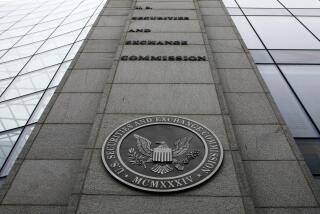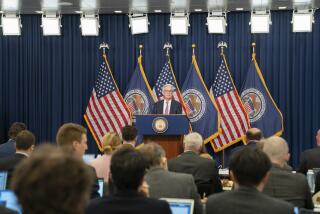WALL STREET CALIFORNIA : Report Gives NASD Mixed Reviews on Its Overhaul : Securities: Overseer appointed after group’s ’96 censure concludes policing is tougher but that staffing, other problems remain.
- Share via
A final report on the three-year regulatory overhaul of the National Assn. of Securities Dealers says that the group has stepped up its policing of the investment industry but remains hampered by staff shortages, high turnover and other problems.
The 179-page report, despite leveling ample criticism, says the NASD has improved substantially as an investor-protection organization since 1996. That’s the year when the NASD settled federal charges that it had turned a blind eye to trading abuses in its Nasdaq Stock Market.
Frederick M. Werblow, installed after the settlement as an independent overseer of the NASD’s regulatory activities, wrote in his final review--to be released today--that “much has been accomplished over the last three years.” He cited, among other things, tougher enforcement, improved procedures for auditing brokerage firms and better surveillance of securities trading.
But Werblow’s report calls on the NASD to improve its regulatory operations further. He also stressed that the booming securities industry and the global ambitions of the expansion-minded NASD are out
stripping the organization’s hiring of additional regulatory staff.
By way of illustration, the report points out that since 1995, the average daily volume of Nasdaq trades and quotations has leaped fivefold, and the average daily share volume has doubled.
In the same period, the report says, the NASD has boosted staffing in various regulatory and enforcement areas in the range of 32% to 40%. Werblow asserted that “none of these increases compare to the activity surges and other challenges” facing the organization.
In addition, the report says the NASD’s absorption of the American Stock Exchange and such factors as Internet trading, day trading and preparation for Y2K issues, “add increasing complexity to the oversight process.”
Werblow said the NASD is still slow in many cases to take disciplinary action against brokerages and brokers, and, in other instances, it fails to pursue evidence of wrongdoing.
Some of the report’s severest criticism centers on high staff turnover, citing one NASD examination unit that has an annual turnover rate of 32%. It recommends bringing in an outside party to study NASD working conditions and pay as a way to improve retention of employees.
The failure to hire and hold on to experienced staff, the report says, undermines the NASD’s examinations of brokerage firms’ finances and sales practices.
The report also cites work backlogs that it attributes to under-staffing. For instance, it says that in 36% of all instances, the NASD’s legal section fails to meet its target for resolving cases in six months.
Mary L. Schapiro, president of the NASD’s regulatory division, said she was encouraged that most of the report’s criticism deals with issues much narrower and less serious than the ones raised by federal authorities three years ago.
“The bottom line is that the independent consultant found that we met the requirements of the undertakings in the 21(a) report, and we’re very proud of that,” she said, citing the investigative report by the Securities and Exchange Commission that brought the censure of the NASD.
Regarding the Werblow report’s finding of personnel shortages, Schapiro noted that the organization’s staffing and its spending on productivity-boosting technology have risen substantially.
“There’s always a limit to the number of people who can be recruited, trained, mentored and deployed in regulation programs effectively. We have benefited from increased resources every year in market regulation, enforcement and examinations,” she said. “We’ll continue to work very, very hard,” Schapiro added, noting that the NASD has pledged to carry out the report’s recommendations.
The NASD’s turnover problem, she said, is far from unique. She noted that the SEC has also been hit by the departure of employees taking higher-paying jobs at securities firms as a result of the industry’s boom.
A three-part series by The Times in July spotlighted the NASD’s general improvement as a regulator, along with the organization’s continuing problems with high turnover, slow enforcement and other areas of investor protection.
The NASD’s overhaul began after federal authorities concluded in 1996 that the organization’s regulators ignored widespread collusion among dealers in the Nasdaq Stock Market to fix prices. The collusion led to fattened profits for some of the brokerage firms belonging to the NASD but did so at the expense of investors, who wound up paying inflated trading costs.
Today, securities market experts say, trading costs are down more than 60% from the peak in the mid-1990s, partly because of greater vigilance by the NASD and because of the rise of alternative electronic trading systems that compete with Nasdaq.
Securities lawyers and regulators outside the NASD also have credited the organization with playing a role in driving out some of the boiler-room operations that bamboozled stock market investors during much of the 1990s.
Amid the overlapping regulatory networks policing the nation’s securities business, the NASD--the industry’s largest self-regulatory group--plays an important role. It often is the first line of defense in protecting investors against rogue brokers and other investment scam artists.
The NASD, which reports to the SEC, registers all of the nation’s stockbrokers, conducts reviews of small brokerage firms and helps the New York Stock Exchange examine the nation’s biggest brokerage firms.
It also is the parent of Nasdaq and the American Stock Exchange. As such, it is responsible for regulating those markets, along with other over-the-counter securities trading.
More to Read
Inside the business of entertainment
The Wide Shot brings you news, analysis and insights on everything from streaming wars to production — and what it all means for the future.
You may occasionally receive promotional content from the Los Angeles Times.










